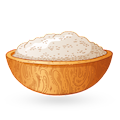MAIN INGREDIENTS
These flower-shaped cookies are prepared with a thin batter which consists of rice flour, eggs, and coconut milk. They are made with specialized achu molds which are heated, then dipped and coated in batter, before the cookies are deep-fried until golden and crispy.
Achappam cookies originate from Kerala, where they are usually associated with Christian communities, but similar sweets are found in other Asian countries. It is believed that all of them were modeled on traditional Dutch cookies known as rosette or struva.
MAIN INGREDIENTS
Karachi biscuits are a famous type of fruit cookie that originates from Hyderabad, India. Named after Karachi Bakery, where they were first made, these biscuits have become an iconic treat from the region. The list of ingredients typically includes a mixture of flour, sugar, ghee, and a unique combination of fruit pieces (such as candied papaya, pineapple, and tutti frutti) and cashews.
Sometimes flavored with cardamom, these cookies have a sweet and mildly spiced taste with a delightful crunch. Karachi biscuits are often packaged in distinct, colorful boxes, making them a popular gift item. Both tourists and locals buy them as souvenirs or presents for friends and family.
MAIN INGREDIENTS
Chandrakanthalu are traditional Indian cookies originating from Andhra Pradesh. They’re made with a combination of green gram (moong dal), sugar, coconut, cardamom, saffron, cashew nuts, and ghee. The dal is soaked, ground into a paste, then mixed with grated coconut and sugar.
The concoction is cooked and formed into a ball. The cardamom, saffron, and chopped cashews are mixed, dipped in water, squeezed until dry, then spread on a board. The cooked mixture is spread on top of the latter one, and the whole thing is pressed in order to create a thin sheet.
TasteAtlas food rankings are based on the ratings of the TasteAtlas audience, with a series of mechanisms that recognize real users and that ignore bot, nationalist or local patriotic ratings, and give additional value to the ratings of users that the system recognizes as knowledgeable. TasteAtlas Rankings should not be seen as the final global conclusion about food. Their purpose is to promote excellent local foods, instill pride in traditional dishes, and arouse curiosity about dishes you haven’t tried.








